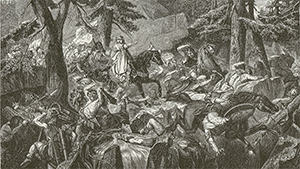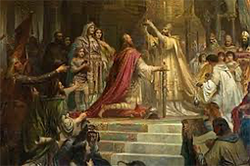Charlemagne
Part 2: War and Consolidation Turning north in 772, Charlemagne targeted the Bavarians and the Saxons. He had little trouble with the former; to conquer the latter took three decades. It was not until 804 that the Saxons submitted to Frankish rule. Pepin had campaigned against the Lombards in the 750s. Charlemagne did so as well, in 773, leaving a large force to continue the fight in Saxony and marching south. He finally subdued the Lombards the following year and brought them into the Frankish fold, naming himself King of the Lombards. 
One of Charlemagne's few failures was an expedition against Muslims armies in what is now Spain in 778. Frankish armies seized the town of Pamplona but could not take Saragossa and so decided to abandon the expedition. During this campaign, the Franks fought in the Battle of Roncevaux Pass, a disaster for the Franks that resulted in the death of the count Roland of the Breton March, whose story is told in the epic poem The Song of Roland. While his troops continued the subjugation of Saxony, Charlemagne continued to fight elsewhere, in Germania and in the Pyrenees. He brought about the destruction of the Avars in 795, seized the island of Corsica, and defeated the Saracens in northern Spain so thoroughly that he was able to establish a buffer known as the Spanish March. (He later set up similar areas along the frontier with Germany and Italy.) 
Charlemagne's war against Saxony was particularly long and involved. After the Saxons burned a well-known Christian church, Charlemagne retaliated by destroying the Irminsul, a tree that was sacred to the Saxons. Turning especially violent, Charlemagne ordered the execution of more than 4,000 Saxons in what historians term the Massacre of Verden. King Sigrfred of Denmark had been allowing Saxons to flee the conflict with the Franks and settle in his kingdom. Charlemagne put a stop to that in 798 and, a few years later, replaced 10,000 Saxons with his own people, deporting the refugees to Neustria. The Saxon leader Sigfred responded with force; his death cut short this campaign, and his successor son asked Charlemagne to end the war. 
On Christmas Day in the year 800, in a ceremony at St. Peter's in Rome, Pope Leo III placed a crown on Charlemagne's head and declared him thus: "Charles, most serene Augustus, crowned by God, great and pacific emperor, governing the Roman empire." The Byzantines were still thinking of themselves as the carriers of the Roman flame at this time, and this pronouncement didn't sit well with the Byzantine emperor, who at the time was Irene of Athens, who had succeeded her husband, Leo IV, on the throne. (The pope considered her invalid to rule because she was a woman.) Charlemagne accepted the title of Emperor of the Romans and established his capital at Aachen, far to the north of Rome. The pope journeyed to Aachen in 805 to consecrate a new chapel that Charlemagne had built there. Next page > Head of a Large Empire > Page 1, 2, 3 |
|
Social Studies for Kids
copyright 2002–2025
David White




